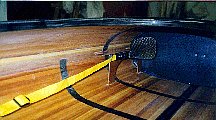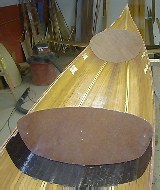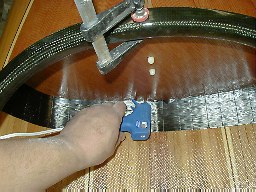
 |
||||
| INDEX | next
|
 |
Bulkheads partition
the kayak into separate compartments. This serves two functions. It
creates watertight storage but more importantly, provides flotation in
case the entire cockpit floods. (The picture shows Cape
Ann Double) |
 |
The
bulkheads here are made from 1/4" plywood coated with varnish. Both are of exact shape as station 7 and 12 of the mold. This is only a dry fit for illustration. Note the holes in the rear bulkhead. The two in the center are for hardware to hold the rear hatch and the two on the sides are ports for rudder cable housing. The black stuff is a band of unidirectional carbon fibers to reinforce the underside of the rear cockpit. The bulkhead further strengthens the area. |
 |
The
best way to hold the bulkhead in place before applying a fillet of silicone
from both sides is to 'stitch' it in place by a few beads of hot melt glue.
The last thing you want, is to dislodge the bulkhead and smear silicone all over the interior of the kayak. The clamp is holding freshly bonded back rest attachment loop. |
| Apply
a bead of marine silicone sealant (or any good quality silicone) on both
sides and smooth it into a wide fillet. The joint need not be reinforced with fiberglass and epoxy, in fact, the bulkhead need not be in contact with the interior of the kayak at all. The silicone can bridge the gap 1/8" (3mm) and it is strong enough to withstand the pressure of a completely flooded cockpit. In general, bulkheads are rarely installed in full contact with the hull skin. Often, fillets and/or cushioning gaskets separate the hull from the bulkheads. One of the reasons is that the bulkhead can 'telegraph' through the thin skins or may worsen the damage to the flexible hull on impact near the bulkhead. Practically speaking, neither of these circumstances apply in wood strip construction. The strip core is too stiff for the bulkhead to 'print through' and the skin may never flex to such degree that a stiff bulkhead would cause more damage on impact. Nevertheless, leaving a little gap for the silicone is a good practice. |
| INDEX |
| Home | Kayak Designs | Kayak Shop | Materials | Kayak Gallery | About us |
| Building Manual | Plans | Sandwich Core | Wood Kayak | Order | |
| Epoxy Test | Abrasion Cloth | Rudder | Resources | Choosing Kayak | Guestbook |
If you notice any problems with the site (i.e. error links, missing images) please, let me know. Thanks
Mail:
Vaclav Stejskal
10 Colonial Court apt. 73
Stoneham, MA. 02180
USA
Tel: 781-481-9261
© 1999
- 2020 Copyright Vaclav Stejskal
All rights reserved
Last page update:
11 January 2020